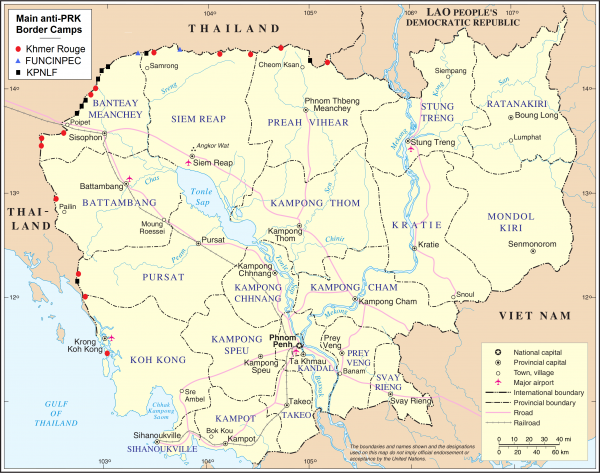
Cambodia has been heavily shaped by its past, particularly the brutal rule of the Khmer Rouge which lasted between 1975 and 1979 under what was known as Democratic Kampuchea. What many people do not realize is that the Khmer Rouge dominated Coalition Government of Democratic Kampuchea (CGDK; Khmer: រដ្ឋាភិបាលចំរុះកម្ពុជាប្រជាធិបតេយ្យ, Odthaphibeal Chamrouh Kampouchea Brachathibtey), renamed to the National Government of Cambodia and that they still retained the Cambodian seat on the UN until 1993, when peace was largely achieved. Alas this was not to the end of the Khmer Rouge.
History of the last Khmer Rouge state.
With UN sponsored elections due to take place, the Khmer Rouge decided to boycott the elections whilst still controlling (at the time) up to 1/6 of Cambodian territory. The Coalition Government of Democratic Kampuchea thus dissolved, the Khmer Rouge fought on under this name, before forming their last “government in exile” and indeed the last Khmer Rouge state.
The Last Khmer Rouge State
In 1994, the Coalition Government of Democratic Kampuchea morphed into the The Provisional Government of National Union and National Salvation of Cambodia (PGNUNSC). This was in opposition to the newly established Kingdom of Cambodia and was not recognized by any state, even their former backer – the People’s Republic of China.
PGNUNSC’s Prime Minister was Khieu Samphan (Democtic Kampuchea’s former head of state) and its Deputy Prime Minister Son Sen (head of S-21). The pseudo country was led by the Cambodian National Unity Party (Khmer: គណបក្សសាមគ្គីជាតិកម្ពុជា) ,the successor party to the Party of Democratic Kampuchea, themselves the successor to the Communist Party of Kampuchea, or as we know them : the Khmer Rouge.
Pot Pot and the last Khmer Rouge state
Pol Pot officially did not hold any power in the The Provisional Government of National Union and National Salvation of Cambodia (PGNUNSC). In reality he was teh de-facto leader until being replaced by Ta Mok.
In 1997, Pol Pot ordered the murder of Son Sen and Ta Mok, which were respectively a success and failure. Following this, Pol Pot was arrested and sentenced to life imprisonment, until he died, allegedly of a heart attack, in 1998.
The end of the Cambodian Civil War
Within 3 months of Pol Pot’s death, the provisional government had been dissolved and the slow road to peace was to begin. The last Khmer Rouge state was at and end. Ta Mok, the last holdout and indeed last Khmer Rouge leader was eventually captured in 1999 ending any vestiges of a Khmer Rouge insurgency.
The main areas of its control were Pailin and Preah Vihear, and most famously Anlong Veng, which is where Pol Pot finally died. It is possible to not only visit his grave here, but also his bunker, as well as many sites related to Ta Mok, the last leader of renegade group.
Interestingly following the win-win policy, which led to the Khmer Rouge disarming the political vacuum was largely filled by former cadre of the Khmer Rouge, who transitioned into government officials.
You can read bout the Win-Win policy here.
Therefore when you visit these areas you will get a much different view to the Khmer Rouge than you would get in the areas of Cambodia that were not under Khmer Rouge control, this is particularly true of Ta Mok, who is still heavily revered in Anlong Veng.
You can read our guide to Anlong Veng, the capital of the last Khmer Rouge state here.





